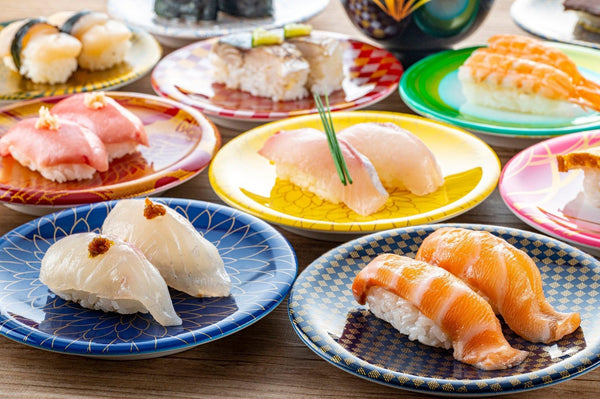
Jump to:
Sushi is right at the top of the list of must-dos for most visitors to Japan.
In a country that tempts visitors with history, culture, one-of-a-kind cityscapes and some of the best cuisine in the world, it's hard to fit it all into one itinerary. Yet most people will inevitably eat at least one sushi meal during their time in Japan, and maybe even more.
With that in mind, your choices of what, where and how to eat sushi in Japan will vary considerably. Whether you only have one sushi experience in Japan or plan to go several times, we recommend that you make a visit to one of the many conveyor belt sushi restaurants found all over this country.
Kaiten-sushi, aka conveyor belt sushi (also pronounced kaiten-zushi), is one of the most popular ways that Japanese people enjoy sushi. Kaiten-sushi is especially good for the visitor to Japan because it gives you a variety of choices, all on a conveyor belt sliding right past your eyes, and is a relatively quick and inexpensive meal to include on a busy itinerary.
Come along with us as we explore the world of conveyor belt sushi in Japan, from budget friendly national chains to more specialized regional and local options, in this edition of the Japanese Taste blog.
Kaiten-Sushi: What Is Conveyor Belt Sushi?

If you've never been to a conveyor belt sushi restaurant, you might have the image of an assembly line or some type of factory experience. While it's true that eating at a kaiten sushi restaurant is a bit more hurried than eating at a high-end sushi bar or Omakase experience, the conveyor belt sushi restaurants still have to meet a minimum quality standard as per the expectations of Japanese culture.
Kaiten-sushi restaurants in Japan typically feature a series of countertops and seats, with a running conveyor belt that brings a series of sushi on plates before the eyes of all of the customers. Some rotary sushi restaurants feature a single counter in an oval or U shape (with the sushi chefs operating in the middle “island”); while others have conveyor belts that snake along a series of tables and booths.
The sushi is constantly being prepared and placed onto the conveyor belts by the sushi chefs, who monitor guest numbers and food consumption throughout the day. Plates that have been sitting on the conveyor belt too long will be removed, so customers need not worry about the freshness of the sushi.
The plates that are coming around on the conveyor belt typically are of specific colors and/or patterns, each reflecting a price point on the menu. Most plates contain two pieces of sushi; some will contain one larger item (or one of a higher price). Other items, such as miso soup or cooked foods, can often be ordered from the kitchen.
When seeing an item that they want, diners simply take that plate off the conveyor belt and put it on their table. The self-service experience is augmented by wasabi and ginger placed at the table or on the conveyor belt; as well as green tea powder and mugs available at the counter (or on the table) to use with a nearby tap of hot water.
What we've described thus far is the traditional conveyor belt sushi experience. Modern technology has streamlined some of the kaiten-sushi restaurants in Japan, particularly those of the national and regional chains. In many conveyor belt sushi restaurants nowadays, customers order off of a touch screen or tablet at their table, and the sushi plates are whisked out on a special lane that is part of the conveyor belt system but comes directly from the kitchen or sushi chefs.
** A recent phenomenon in Japan at the time of this article's writing has expedited the need for this technology further; we will get into that later in this article.
When a diner has finished eating his or her meal, the bill is tabulated by adding the number of plates of each price category. As you can imagine, this entire process speeds up the average dining experience, and turnover on each seat/table is much higher than in a typical restaurant. This enables conveyor belt sushi restaurants to serve quality sushi at affordable prices.
In a society that is both quality conscious and price conscious, the kaiten-sushi experience ticks off a lot of the boxes and thus has created a very popular dining phenomenon. But where and how did it all start?
History Of Conveyor Belt Sushi

The conveyor belt sushi concept started in the 1950s in Japan. Imagine a society in the events of a post-war rebuild determined to become an economic success story. Meals were not something to be enjoyed slowly but rather to be a filling and fast experience.
The rather commonly accepted origin story goes something like this. A gentleman named Shiraishi was working in the Asahi beer factory, and saw the conveyor belt used as part of the beer bottling assembly line process. A creative and enterprising fellow, Shiraishi-san thought about different ways that this process could be applied in the restaurant business, and came up with the idea of conveyor belt sushi.
His restaurant was called Genroku Sushi, and at the height of its popularity years later this popular rotary sushi chain had hundreds of locations across Japan. Genroku expanded outside of Japan's borders thanks to the 1970 World Expo in Osaka, which featured one of their conveyor belt sushi restaurants.
As Japan boomed as a world economic power through the 1970s and '80s, many other chains opened across the country to compete with Genroku for the increasing demand both for sushi and for kaiten-sushi specifically. The idea of a quick, in-and-out experience that still delivered on quality (as opposed to McDonald's or other types of fast food) became very popular – not only among single diners (especially “salarymen”) but families, couples and indeed all corners of Japanese society.
In the last couple of decades, as Japan's economic power has come down from its peak, the cost-conscious Japanese society has taken to conveyor belt sushi restaurants even more as they provide a quality meal experience at an affordable price. Thus kaiten-sushi remains popular in Japan today, both among Japanese people and among visitors as well.
Why Choose Conveyor Belt Sushi In Japan
It's easy to see why cost-conscious Japanese would opt for conveyor belt sushi. For visitors, this is an experience that fits well with itineraries and budgets of all shapes and sizes.
Conveyor belt sushi restaurants in Japan deliver consistently well on convenience, speed and casual atmosphere; but at the same time they provide the diner with quality sushi and other foods.
Even if you see a line in the lobby or out the door at a conveyor belt Sushi restaurant, fear not; it's likely to move quickly as the dining experience usually lasts 20 minutes or so. If you go to a rotary sushi restaurant at any other time besides peak hours, you're likely to get in and out in less than half an hour.
Whether you are visiting Japan as a solo traveler, a couple, friends or family, there's something in a conveyor belt sushi restaurant for nearly everyone. The menus tend to be wide and varied, and of course the food comes quickly and lets you get on with your day in a matter of minutes.
Types/Styles Of Sushi Offered At Conveyor Belt Sushi Restaurants In Japan

There is a minimum level of quality and variety that nearly every sushi restaurant in Japan generally needs to meet, even those of the kaiten-sushi variety.
This means that, in virtually every sushi restaurant (including those with conveyor belts) you will see the standard sushi items such as tuna (in many varieties and cuts), shrimp, squid, octopus, salmon, eel and mackerel. Other types of fish, shellfish, vegetables and even meat can be prepared as sushi.
The most common preparation of sushi is nigiri sushi, which involves placing a slice of fish (or other ingredient) on top of a tightly-packed bed of vinegared rice. You're also likely to encounter sushi rolls, both the long rolled variety as well as the cone shaped hand rolls.
If you're in a restaurant with a touch screen or tablet menu, you're likely to see an option to order in English or other languages. Choosing a more traditional conveyor belt sushi restaurant? Don't hesitate to ask the sushi chef or server what is available or what an item is. At the very least, through visual means and perhaps a dictionary or handy app, you're likely to get a translation of the items.
Concerned about whether the item is cooked or raw? Well of course most sushi items are raw, but not all; again you can point and ask “nama deska?” (“is this raw?”) However, because of the high standard of quality in Japan, all of the ingredients are meticulously handled and held at proper temperatures, both out of obligation and common sense as well as the desire to avoid any kind of PR issues.
Lesser Known Conveyor Belt Sushi Items for Tourists (+ Non-Sushi Items)
In addition to the traditional sushi favorites, in many conveyor belt sushi restaurants you are likely to encounter sushi variants that include mayonnaise, vegetables, tempura… even cheese or hot sauce.
As the world of rotary sushi evolves, the variety and choices seem to be stretching out to endless amounts and permutations. Perusing the offerings for national kaiten-sushi chains such as Kura Sushi and Sushiro, you’ll find literally hundreds of items on their menus.
And the options don't stop at sushi. If you and or your dining companion(s) want something from the kitchen, the choices expand into tempura, fried chicken, soups, curries, rice bowls, ramen and many other Japanese favorites.
Indeed, a trip to the conveyor belt sushi restaurant in Japan proverbially offers something for everyone.
The Typical Conveyor Belt Sushi Experience vs Higher-End Kaiten-Sushi

In the arena of conveyor belt sushi, price point largely dictates the level of quality and experience. Price is a fairly constant marker and thus there's something available for a variety of budgets for the visitor to Japan.
The aforementioned national chains of conveyor belt sushi restaurants (Kura & Sushiro) along with rivals Genki Sushi, Uobei, Hama Sushi and others, are fairly basic but also deliver a consistent product and experience every time. For those willing to venture into regional chains or local conveyor belt sushi restaurants, the level of quality varies from entry level to higher end.
Entry level might also be a hole-in-the-wall type of place located near or even under the train tracks, but it still delivers solid sushi and you'll know what's popular based on queues and reviews. The traditional price point for entry level conveyor belt sushi was 100 yen per plate and up. Inflationary pressures, however, have begun to force an uptick in prices, and the starting point is often closer to 115 or 125 yen per plate for entry level sushi items. Sushi such as sea urchin (uni), fatty tuna (toro) and other high-end cuts and items can fetch upwards of 500 yen a plate or more.
Be sure to check the touch screen, signage or with the server about specials, as these can be some real bargain finds for the inquiring sushi visitor!
While the national chains tend to be large, cavernous and a little bit noisy (although still pretty quiet by Western standards), increasing your price point can fetch some great results in regional chains and local restaurants. These conveyor belt sushi bars tend to be smaller and more personal. If you sit at the counter, for example, you can order directly from the sushi chef and even chat with them if you like.
If the latter sounds more like a traditional sushi bar, you're not mistaken. This is where the world of conveyor belt sushi starts to become a hybrid with more traditional sushi restaurants. These restaurants are more likely to have a touch pad or personalized ordering, and if there is a conveyor belt it might only have advertising/information about specials and other sushi items. Most importantly, the sushi will be of better cuts, higher quality, and better proportion of fish to rice.
The prices are anywhere from 50% to 100% higher than the standard rotary sushi restaurants, but still an affordable option compared to higher-end sushi bars, and still get you great quality sushi nonetheless.
Rotary Sushi Etiquette: How To Order & How To Pay

Regardless of which type of conveyor belt sushi restaurant you choose, along with the minimum quality of product and service comes a set of unspoken rules and etiquette.
Seating at the counter is generally first come first serve, while conveyor belt sushi restaurants that have booths or tables feature either a host/hostess at the entrance or an automated numbering system that instructs you where to sit.
Many of the unspoken rules and standards exist for the safety and comfort of those dining around you and after you. After all, consider how many people sit at the same place as you are sitting on a given day in a kaiten-sushi restaurant, Then multiply that by the number of seats in the restaurant and you can imagine how things could get out of control if sanitary standards weren't maintained.
It’s best to use chopsticks to eat your sushi. If you are not able to or comfortable with using chopsticks, your choices are limited to either asking for a fork (which admittedly is not a great look) or eating with sushi with your hands. While not taboo, it's best to limit only one hand to eat with, and use the other hand for taking items such as soy sauce, ginger, items off the conveyor belt, etc.
When items pass in front of you on the conveyor belt, don't touch anything unless you are going to take it. Even if you've inadvertently touched something on the conveyor belt, it's best to take it at that point and just try it anyway.
You may have already noticed that Japan is a very quiet and respectful society. That's why whether you're in a conveyor belt sushi restaurant or any kind of restaurant in Japan, it's best to keep conversation volume low, and not to talk on your phone.
If you're at a rotary sushi restaurant where the actual sushi passes in front of you, know that your bill will be tabulated efficiently and correctly by the number of plates at each price point (please don’t be “that guy” and try to hide plates – they know what you’re up to, and it gives all other visitors a bad name in a country known for respect and good behavior). If you're ordering off of a tablet or touch screen, the running total will be displayed on the screen as well. When finished, you will get a receipt which you can take to the counter to pay on your way out. Tax is typically added to the bill, and remember that tipping Is never done in Japan.
Conveyor Belt Sushi “Nuisance” and Nonsense: How the Sushi Industry Struck Back
In 2022 and 2023, a series of incidents at conveyor belt sushi restaurants and other restaurants in Japan left the fast casual restaurant industry reeling. A handful of bad apples were about to ruin the proverbial crop.
In videos that went viral, a few diners were seen licking items at the tables and on the conveyor belts in national kaiten-sushi chains, which left an entire nation understandably reluctant to eat at these and similar restaurants.
The industry responded swiftly by renouncing the videos and incidents as bad behavior, of course, but they also implemented additional health and safety measures.
Many conveyor belt sushi restaurants at the time of this article's writing had switched to a touchpad ordering system, and the conveyor belts have been left empty or simply with signs and photos advertising the various offerings of the restaurant.
Some kaiten-sushi restaurants have added lids to the plates, which lock into place and even have features of tampering detection. Also, if you're in a kaiten-sushi chain restaurant or a bigger conveyor belt sushi restaurant, it's a pretty good bet that you are on camera somewhere as are all of the diners throughout the establishment. All this is being done for the safety of the clientele as well as to safeguard the reputation of the restaurants.
Hopefully we won't see any more of these incidents. If you are traveling with sanitizing gel and or alcohol wipes, it's probably a good idea to use this after touching surfaces such as soy sauce bottles etc, although the industry standard is that these are in fact cleaned in between table turnover.
And remember, Japanese culture is known for its meticulousness when it comes to safety and quality. That means you’re in for a treat no matter where you choose to eat in Japan; and conveyor belt sushi restaurants are no exception.
Kaiten Sushi: A Must-Visit In Japan

As you can tell by now, we highly recommend a visit to a conveyor belt sushi restaurant on your journey to Japan.
Whether you opt for one of the nationwide rotary sushi chains, or you go for a regional or local conveyor belt sushi option, your experience is bound to be a delicious and memorable one.
Have you been to a conveyor belt sushi restaurant in Japan or elsewhere before? Let us know about your kaiten-sushi experiences in the comments below.
Curious to know about our kaiten-sushi recommendations? Then be sure to check out this article next.


0 comments